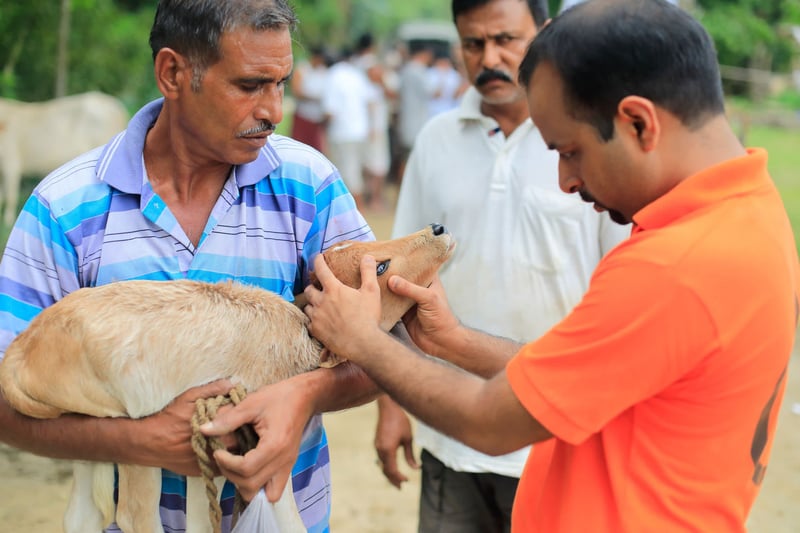
Protecting animals from natural disasters before they strike: reducing risk is not negotiable, it saves lives
News
It’s not enough to respond only after a disaster has struck. It is extremely important to be prepared to handle any disaster or emergency like situation and proactively protect animals and animal owners.
Our disaster teams act as quickly as possible to save the lives of animals after naturals disasters hit.
We urgently deployed to the Caribbean after Hurricane Irma hit only last month, and before that we were on ground helping distressed animals and animal owners when floods hit India and Nepal. During a typical response, we feed and give medical care to tens of thousands of animals in urgent need of help.
But outside these emergency situations, we carry out vital work to reduce the impact of disasters on animals and the people who rely on them. As we teach communities how best to protect their animals, and provide them with resources to do so, we’re safeguarding lives and livelihoods.
This means that if the worst does happen, fewer animals will suffer or die.
Over a billion poor people rely on animals for food and income. 752 million livestock keepers live on less than $2 a day. We know that the poor are most vulnerable in disasters as they often are highly exposed to hazards, and have less capacity to cope, adapt and recover.
Every year India suffers an average US$ one billion in disaster losses, and direct natural losses amount to almost 2% of India’s GDP and up to 12% of the central governments revenue. On average 95,000 cattle are lost every year from floods alone. India is particularly vulnerable to natural disasters on account of its geo-climatic conditions, being prone to earthquakes, floods, cyclones and droughts. Due to the scale of the country and the diversity of climates, state governments play a key role, alongside the national government, in reducing risks and preventing losses.
Last year India became one of the few countries to have integrated rescue, relief and rehabilitation of animals during disasters in their national disaster management plan. Since 2008, World Animal Protection in coordination with the National Disaster Management Authority (NDMA), National Institute of Disaster Management (NIDM), National Disaster Response Force (NDRF), Department of Animal Husbandry, Dairying & Fisheries (DADF) at centre and state level, veterinary institutions, and other partner organizations have taken major steps towards disaster risk reduction.
The National Disaster Response Force Training Programme aims at imparting knowledge and skills to the NDRF Trainers to effectively manage the animal welfare needs in emergencies and protect the livelihoods of the communities dependent on livestock for their survival.Since December 2013, a total of 237 master trainers have been trained from all the 12 Battalions in 7 training batches in coordination with the 6 VERUs. They have further imparted trainings to their rescue teams and also to the local communities in the most vulnerable areas.
In 2009, following the Kosi river flood in north Bihar, and frequently occurring major disasters in India: the Bihar Veterinary College, with the support of World Animal Protection, initiated India’s first Veterinary Emergency Response Unit (VERU).
Following the success in Bihar, VERUs have been established in five key regional hubs in India:
North - Palampur
South - Chennai
West - Anand
East - Guwahati
Central - Jabalpur, with an additional unit in Patna.
We have also successfully introduced VERUs in Costa Rica, Mexico, Nicaragua, Colombia, Thailand and Myanmar.
The Veterinary Emergency Response Units (VERU) located in key veterinary colleges in India, deliver internationally recognised training and lectures, both theoretical and practical, to final year veterinary students. The program is supported by the National Disaster Management Authority (NDMA) and World Animal Protection. Upon completion; the students emerge with a VERU certificate, accredited by the NDMA and World Animal Protection.
Students learn all aspects of veterinary care needed to quickly respond to protect animals in emergencies and disasters.
While preparing veterinarians to support vulnerable communities, who rely on animals for their livelihoods and for companionship, in disaster preparedness. VERUs also work effectively alongside government partners and humanitarian NGOs in major emergency response situations.
The theme of this year’s International Day for Disaster Reduction is Home Safe Home. This theme promotes the idea that we should ensure our homes are as safe as possible for our family. And of course for most people, pets and farms animals are part of the family.
We need to take every step we can to keep them safe from disasters.
People living in places prone to flooding or earthquakes, should have a plan to determine the safest place in their home. In case of evacuation, people need to make sure they have a safe route and place to go with their animals.
Emergency kits can be prepared, that include water and food for people and animals, a flashlight, a safe place for your animals to sleep such as a kennel, and more.
We should always include our pets and animals in emergency plans. They suffer just like we do during disasters, and they depend on us.